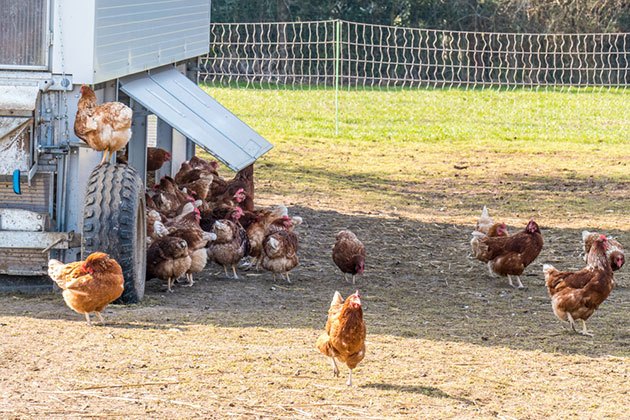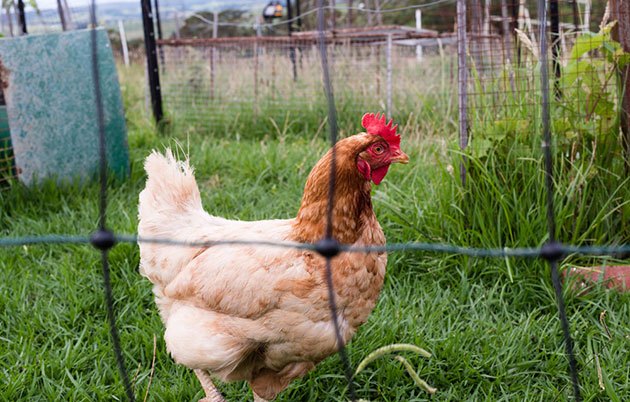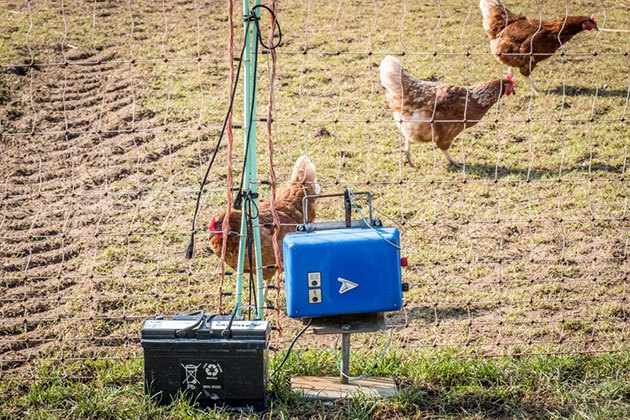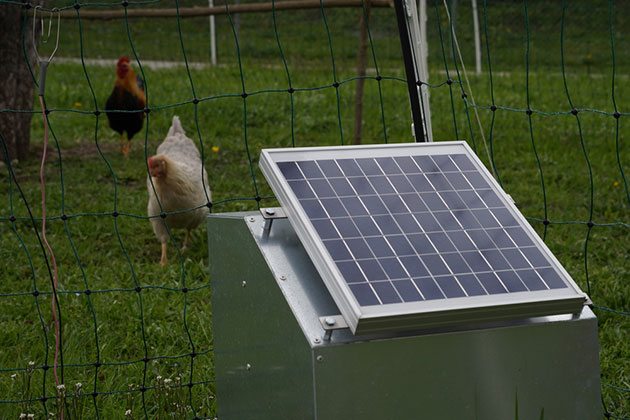Electric fencing is an affordable and productive solution containing pastured broilers and free-range poultry.
The construction also deters predators, including coyotes, wolves, foxes, birds of prey, raccoons, wild dogs, etc.
When installing an electric garden fence for chickens and poultry, ensure the fencing offers sufficient space for their needs. Animals need a lot of space with insects, grass, and gravel.
In addition, you need to follow other specifics necessary for good electric fencing.
What are these? Stay tuned.
Table of Contents
- Are chickens tricky?
- What is the best electric fencing for poultry?
- What are the electric fencing types?
- How to install an effective electric fence?
- How does a system work?
- How do you deter predators?
- How to keep chickens inside the electric poultry netting?
- Can you build your chicken electric fence?
- Can you repair chicken fencing?
- FAQs
- Summary
Are chickens tricky?

Setting up an electric fence for poultry, turkeys, chickens, etc., seems challenging and tricky. However, the birds can quickly fly over the electric fences.
It may happen in the wild, but it’s not that possible with farm-raised, free-range poultry.
In farm settings, farmers usually clip their wings, allowing them to be managed by electric fencing.
What is the best electric fencing for poultry?
The large confinement with access to grass, insects, and gravel and the possibility of freely moving around is the best idea to keep the farmers and poultry happy.
However, if you follow the basics, you can quickly get a certificate from the U.S. Department of Agriculture.
So, the most productive, cost-effective solution to detain poultry is an electric fence. To construct the system for birds, you will need:
- electric fence wire – aluminum wire
- insulators – necessary for T-posts or wood posts
- fence posts – permanent or semi-permanent
- fence chargers – battery, plug-in, or solar chargers
- ground rods
- fence tester – voltage tester
- fence tools – components for fence installation and maintenance
What are the electric fencing types?
1. Fence wires
Multiple variations of electric fencing refer to the fence wire. Thus, the poultry fencing recognizes.
a. Two-wire system
This system uses a single wire between 4 and 6 inches off the ground and a second wire 10 inches above the ground.
The two-wire system is excellent for chickens, turkeys, and other poultry located in the larger areas, not tightly fenced runs.
In spite of their ability to fly, chickens and turkeys can be confined with a short fence too.
b. Electrified poultry netting
The electrified mesh netting is an effective solution, keeping predators out of the fence and poultry – chickens inside the fence.
However, the poultry netting needs extra cost and requires regular maintenance to prevent the current from shorting out.
You can find various electric netting sizes and rolls.
c. Combination
You can add electric wire to the existing fence line.
The ground wire is the most important wire, and it must be 4 to 6 inches above the single-strand fence wire.
Another electric wire can be added to the top of the fencing to deter climbing predators. It’s another crucial wire.
Plastic insulators or T- or wooden posts will also be productive. And experts recommend a galvanized steel wire for the bottom wire.

2. Electric fence chargers
To make your electric fencing productive and keep poultry safe will need a suitable power source.
It would help if you had a low-impedance fence charger. But, again, you can find the best models HERE or go for the Gallagher model.
- TAKE IT ANYWHERE – The S100 Electric Fence Charger is perfect for remote locations with unreliable or no access to mains power. Powers up to a 30-mile single wire fence or 8 miles of multi-line...
- PORTABLE AND SUPER TOUGH SOLAR FENCE ENERGIZER: The Gallagher S100 is a portable, super tough unit that’s quick and easy to install and comes with a built-in solar panel and 12V battery. Perfect for...
- PEACE OF MIND OF A RELIABLE SOLAR ENERGIZER, WHATEVER THE WEATHER - Gallaghers unique battery saving technology can maintain power to your fence for up to 3 weeks without sun. With Multiple Power...
- PACKED WITH FEATURES – The S100 Solar Electric Fence Charger comes with 360-degree mounting capability for easy installation, automated battery management indicator light and dual power options,...
- BUILT TO LAST - Gallagher is the trusted name in animal management solutions. The S100 Solar Energizer comes backed by a full 3 Year manufacturers warranty. Order it with no risk today.
However, you can try various two-mile models specifically created to contain large poultry species and massive chickens.
A charger maintaining 5,000 volts of primary power is an excellent solution for deterring predators and keeping poultry secure.
In addition, having a solid AC charger will generate electricity through a complete fencing system to push past barriers and fight weeds, grass, and other vegetation.
The bottom wire will be only 6 inches above the soil, so you need to make the whole construction effective.
3. Fence posts
The step-in posts have multiple benefits.
First, they are ideal for electric poultry fencing with wire strands. They offer a quick setup yet are solid enough to hold the wiring system firmly.
For a correct electric fence installation, you need to apply multiple posts to keep a good tension on the line.
More posts ensure a better ground contour, as it eliminates gaps that lead to escaping. So, your chickens will be fenced tightly.
Another big plus is that these electric poultry systems do not require a gate. The wire lines are low – you can quickly step over the fence to enter and exit.
If you need to bring a truck, heavy loader, or tractor near the fence on the pasture, pull up some posts, and drive carefully over the edge.
Finally, the step-in posts help you with vegetation maintenance and cleaning procedures.
You can pull them out, move them around and re-install them for a specific project.
How to install an effective electric fence?
Chicken electric fences are quick and effortless to set up and use.
The most common setups include either a one-wire or two-wire mechanism.
For a correct installation, please follow the steps below:
- install posts around the perimeter fence unit at regular intervals
- when using permanent fence posts, place two sets of insulators on each unit
- place the bottom strand of aluminum wire at around 6 inches above the ground
- when needed, put an extra strand of wires at 10-12 inches above the bottom wire.
- tighten both strands correctly
- set up ground rods
- connect the charger to the rods and the fence
- test the fence output at regular intervals for proper voltage levels.
Your fence must be at least 4 feet tall!
How does a system work?

The system has the same procedure as any other electric fence for different animals.
The charger transforms the battery or mains power into high voltage pulses on the fence line.
The pulse becomes a shock that hits the animal touching the wire, as the circuit will complete, and the animal will feel the shock.
The current then travels through the earth back to the grounding system and completes the circuit.
So, the pulse/shock teaches animals to respect their boundaries, creating psychological and physical barriers.
How do you deter predators?
Many farmers are surprised when they discover that only two strands of fencing wires can keep various beasts – foxes, wolves, coyotes, dogs, raccoons, bobcats, etc. away from the electric poultry netting.
The main reason for this is that these animals are not that big.
Although jumping over the fencing construction is possible, it takes advanced agility. Fortunately, these animals don’t have it to that extent.
Other predators are not that intelligent to develop effective tactics and avoid contact with an electric shock.
Also, remember that when most animals – both domestic and predators come in contact with the fences, the shock is quite an experience.
It either teaches them never to return or only causes an unpleasant feeling but insufficient to try again.
How to keep chickens inside the electric poultry netting?
Clipping the wings of chickens and other poultry is a crucial factor in protecting them in the flock.
Clipping wings to gees, turkeys, or chickens will keep them on the ground, preventing them from flying up in the sky, over the fence, or onto the trees or roofs.
When clipping hens, don’t forget that you need only one wing with cut flying feathers. You don’t need to trim both wings.
Once you clipped their wings, your hens, chickens, and other birds are prepared for free-range dwelling.
Yet, to completely protect them, an electric fence is the best low-cost and productive way to contain them in a larger outdoor enclosure.
The chicken will forage without roaming away from the property.
Can you build your chicken electric fence?
Yes, you can.
You will need appropriate fencing material and essential knowledge to create good-working fencing and protect your hens.
There are seven required components for a productive fence, as you have seen above. Once you gather them all, you can start building your construction.
But, before any action, you must determine the precise type of animal you want to either deter or protect.
You may want to keep horses, sheep, hens, goats, or pets inside and chase foxes, dogs, coyotes, or wolves away.
You determine the exact size and height of the fence to keep the captive animals safe and beasts away from the fences.
Also, it would help if you determined the exact place of the electrified enclosure – your backyard, grass yard, gardens, or other similar areas.
You will know exactly what size and height of the electrified fence you will need according to these two variables.
Once you determine the fence type – wire strands or netting, permanent or temporary fencing, you need solid construction units to hold it tightly – the posts.
Keep in mind that permanent chicken fences need more robust steel or wood posts, supporting high-tensile wires, wide tape, woven wire, or rope.
Permanent models are more robust than similar units but more expensive and might require a professional installer.
Remember that netting might require a few more stakes for a proper setup.
You can use various posts – from metal to plastic models. Some require insulators, others don’t, depending on the type and purpose.
Of course, your fence cannot function without power. So, it would be best if you found an appropriate charger to meet your standards.
If you set up a chicken fence, remember that feathers are good insulators.
So, you will need a higher voltage to ensure they receive a shock and stay away from the backyard boundaries.
Once you place the posts and rods into the ground, it’s time to connect wire strands.
Again, depending on the chosen model, you will/will not use the insulators to hold them tightly.
However, it would be best to refer to our guidelines above and see the best wire options. And after you connect all components, you can turn the circuit on.
Once the chicken, sheep, goat, or any other animal comes in close contact with the electrical wire, the electric current passes through the animal to the earth ground and completes the circuit.
The chicken will feel the shock. And, don’t forget to install an exemplary ground circuit, or else the fencing won’t be adequate.

Can you repair chicken fencing?
Yes, you can. You will need a repair kit, and you can easily set it up.
You won’t have to search for an electrician, as the kit contains all the essential elements:
- an energizer,
- an earth stake,
- a length of poultry fencing with sturdy poles,
- and other repairing features for minor hiccups of the structure.
A kit will also permit you to create a proper physical and psychological barrier around your veggie patch, raised garden beds, or plot.
So, once you find an issue, please, repair it instantly to avoid further complications and potential high risks.
Keep your and your animals’ safety above everything else!
And, don’t forget to clean and maintain your property and fencing regularly.
Any kinds of weeds, grass, and similar vegetation can damage the voltage levels and wire strands and cause short circuits, especially in wet conditions.
Ensure the whole construction is free of herbs and other problematic plants. Or else, your structure won’t be as effective as it should be against any animal type.
FAQs
Can you use an electric fence for chickens?
Yes, you can. In fact, chicken fences are ideal solutions to keep them in enclosed areas and protect them from predators.
However, it requires regular maintenance, especially in the summer months when the grass and other vegetation grow, but once installed, it should give you years of security and protection.
Do invisible fences work for chickens?
Many farmers agree it does not work with chickens. There are three main reasons:
- the current might be too strong
- they might not understand the meaning of the invisible mechanisms
- it doesn’t work even for a cat or dog so it won’t be that effective for chicken
Is a 4-foot fence tall enough for chickens?
Yes, it will be enough.
However, it will be enough if the chicken run has a top cover of bird netting or roof. It might be enough for chickens with clipped wings too.
Summary
So, do you plan to keep chickens in the backyard or a similar area? If you do, you will undoubtedly need an electric garden fence for chickens.
Please, stick to our guidelines & find the best model for your needs. It would be best to calculate all variables and determine the exact plant for your mechanism.
That way, you can easily construct a productive fence type for your needs.
Good luck, farmers!


